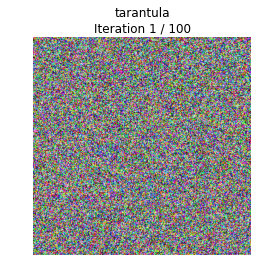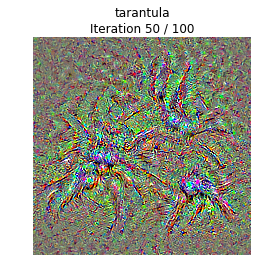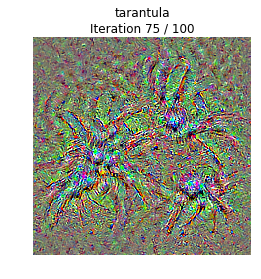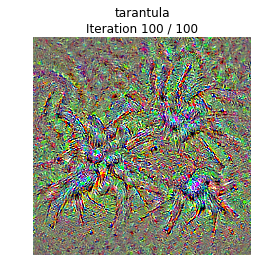Saliency Maps
一张saliency map告诉了我们在图片中的每个像素点对于这张图片最后的预测得分的影响程度。为了计算它,我们要计算正确的那个类的未归一化的打分对于图片中每个像素点的梯度。如果图片的尺寸是(H,W,3),那么梯度的尺寸也应该是(H,W,3);对于图片中的每个像素点,梯度值反映了如果某个像素点的值改变一点点,分类的打分(score)会改变的程度大小。为了计算saliency map, 我们用梯度的绝对值,然后在3个channel上面求最大值,因此最后的saliency map的形状应该是(H,W),并且所有的值都是非负数。
def compute_saliency_maps(X, y, model):
"""
Compute a class saliency map using the model for images X and labels y.
Input:
- X: Input images, numpy array of shape (N, H, W, 3)
- y: Labels for X, numpy of shape (N,)
- model: A SqueezeNet model that will be used to compute the saliency map.
Returns:
- saliency: A numpy array of shape (N, H, W) giving the saliency maps for the
input images.
"""
saliency = None
# Compute the score of the correct class for each example.
# This gives a Tensor with shape [N], the number of examples.
#
# Note: this is equivalent to scores[np.arange(N), y] we used in NumPy
# for computing vectorized losses.
correct_scores = tf.gather_nd(model.scores,
tf.stack((tf.range(X.shape[0]), model.labels), axis=1))
###############################################################################
# TODO: Produce the saliency maps over a batch of images. #
# #
# 1) Compute the “loss” using the correct scores tensor provided for you. #
# (We'll combine losses across a batch by summing) #
# 2) Use tf.gradients to compute the gradient of the loss with respect #
# to the image (accessible via model.image). #
# 3) Compute the actual value of the gradient by a call to sess.run(). #
# You will need to feed in values for the placeholders model.image and #
# model.labels. #
# 4) Finally, process the returned gradient to compute the saliency map. #
###############################################################################
#(1)(2) 分数对于输入图像的梯度
saliency_grad = tf.gradients(correct_scores,model.image)
#(3) 运算求值
saliency = sess.run(saliency_grad,feed_dict = {model.image:X,model.labels:y})[0]
#(4) 处理
saliency = np.absolute(saliency) #求绝对值
saliency = np.amax(saliency,axis = -1) #求三个channel上最大的值
##############################################################################
# END OF YOUR CODE #
##############################################################################
return saliency

Fooling Images
我们也可以用图像梯度来生成一些”fooling images”,正如[3]中讨论的那样。 给定了一张图片和一个目标的类,我们可以在图片上做梯度上升来最大化目标类的分数,直到神经网络把这个图片预测为目标类位置。
def make_fooling_image(X, target_y, model):
"""
Generate a fooling image that is close to X, but that the model classifies
as target_y.
Inputs:
- X: Input image, a numpy array of shape (1, 224, 224, 3)
- target_y: An integer in the range [0, 1000)
- model: Pretrained SqueezeNet model
Returns:
- X_fooling: An image that is close to X, but that is classifed as target_y
by the model.
"""
# Make a copy of the input that we will modify
X_fooling = X.copy()
# Step size for the update
learning_rate = 1
##############################################################################
# TODO: Generate a fooling image X_fooling that the model will classify as #
# the class target_y. Use gradient *ascent* on the target class score, using #
# the model.scores Tensor to get the class scores for the model.image. #
# When computing an update step, first normalize the gradient: #
# dX = learning_rate * g / ||g||_2 #
# #
# You should write a training loop, where in each iteration, you make an #
# update to the input image X_fooling (don't modify X). The loop should #
# stop when the predicted class for the input is the same as target_y. #
# #
# HINT: It's good practice to define your TensorFlow graph operations #
# outside the loop, and then just make sess.run() calls in each iteration. #
# #
# HINT 2: For most examples, you should be able to generate a fooling image #
# in fewer than 100 iterations of gradient ascent. You can print your #
# progress over iterations to check your algorithm. #
##############################################################################
score = model.scores[0, target_y]
dX = tf.gradients(score, model.image)[0]
dX = dX / tf.norm(dX)
for i in range(100):
ascent_step, scores = sess.run([dX, model.scores], feed_dict={model.image:X_fooling})
if np.argmax(scores, axis=1) == target_y:
break
X_fooling += learning_rate * ascent_step
##############################################################################
# END OF YOUR CODE #
##############################################################################
return X_fooling

Class visualization
我们可以合成一张图片来最大化一个特定类的打分;这可以给我们一些直观感受,来看看模型在判断图片是当前这个类的时候它在关注的是图片的哪些部分。
通过产生一个随机噪声的图片,然后在目标类上做梯度上升,我们就可以生成一张模型会认为是目标类的图片了。
def create_class_visualization(target_y, model, **kwargs):
"""
Generate an image to maximize the score of target_y under a pretrained model.
Inputs:
- target_y: Integer in the range [0, 1000) giving the index of the class
- model: A pretrained CNN that will be used to generate the image
Keyword arguments:
- l2_reg: Strength of L2 regularization on the image
- learning_rate: How big of a step to take
- num_iterations: How many iterations to use
- blur_every: How often to blur the image as an implicit regularizer
- max_jitter: How much to gjitter the image as an implicit regularizer
- show_every: How often to show the intermediate result
"""
l2_reg = kwargs.pop('l2_reg', 1e-3)
learning_rate = kwargs.pop('learning_rate', 25)
num_iterations = kwargs.pop('num_iterations', 100)
blur_every = kwargs.pop('blur_every', 10)
max_jitter = kwargs.pop('max_jitter', 16)
show_every = kwargs.pop('show_every', 25)
# We use a single image of random noise as a starting point
X = 255 * np.random.rand(224, 224, 3)
X = preprocess_image(X)[None]
########################################################################
# TODO: Compute the loss and the gradient of the loss with respect to #
# the input image, model.image. We compute these outside the loop so #
# that we don't have to recompute the gradient graph at each iteration #
# #
# Note: loss and grad should be TensorFlow Tensors, not numpy arrays! #
# #
# The loss is the score for the target label, target_y. You should #
# use model.scores to get the scores, and tf.gradients to compute #
# gradients. Don't forget the (subtracted) L2 regularization term! #
########################################################################
loss = None # scalar loss
grad = None # gradient of loss with respect to model.image, same size as model.image
pass
loss = model.scores[0,target_y]
grad = tf.gradients(loss,model.image)[0]
grad -= 2*l2_reg*model.image
############################################################################
# END OF YOUR CODE #
############################################################################
for t in range(num_iterations):
# Randomly jitter the image a bit; this gives slightly nicer results
ox, oy = np.random.randint(-max_jitter, max_jitter+1, 2)
X = np.roll(np.roll(X, ox, 1), oy, 2)
########################################################################
# TODO: Use sess to compute the value of the gradient of the score for #
# class target_y with respect to the pixels of the image, and make a #
# gradient step on the image using the learning rate. You should use #
# the grad variable you defined above. #
# #
# Be very careful about the signs of elements in your code. #
########################################################################
dX = sess.run(grad,feed_dict={model.image:X})
X += learning_rate * dX
############################################################################
# END OF YOUR CODE #
############################################################################
# Undo the jitter
X = np.roll(np.roll(X, -ox, 1), -oy, 2)
# As a regularizer, clip and periodically blur
X = np.clip(X, -SQUEEZENET_MEAN/SQUEEZENET_STD, (1.0 - SQUEEZENET_MEAN)/SQUEEZENET_STD)
if t % blur_every == 0:
X = blur_image(X, sigma=0.5)
# Periodically show the image
if t == 0 or (t + 1) % show_every == 0 or t == num_iterations - 1:
plt.imshow(deprocess_image(X[0]))
class_name = class_names[target_y]
plt.title('%s
Iteration %d / %d' % (class_name, t + 1, num_iterations))
plt.gcf().set_size_inches(4, 4)
plt.axis('off')
plt.show()
return X




